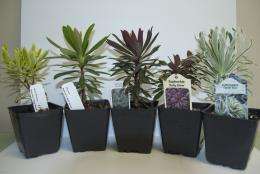Fight droughty dullness with cool-season euphorbias

Find the lack of fall colors this year depressing because of the drought? Texas Superstars newest selections, cool-season euphorbias, can brighten up landscapes throughout the winter, said a Texas AgriLife Extension Service expert.
Cool-season euphorbias can add splashes of lime green, cream, pink and maroon with either solid or variegated foliage, said David Rodriguez, AgriLife Extension horticulture agent in Bexar County.
Moreover, October is the perfect time to start planting the perennials.
“The keys to getting cool-season euphorbias off to a good start and ensuring they last through our winters are good bed preparation and early planting,” Rodriguez said.
There are seven Texas Superstar cool-season euphorbia selections: Ascot Rainbow, Tiny Tim, Rudolf, Glacier Blue, Purpurea, Blackbird and Ruby Glow.
Cool-season euphorbias take full sun to partial shade, and because they have been through the Texas Superstar selection process, they are “Texas tough” and adapted to conditions throughout the state, from the Panhandle to South Texas, said Rodriguez, who is based in San Antonio.
Doing well throughout the state is the first prerequisite for a plant to be admitted to Superstar ranks, said Dr. Brent Pemberton, Texas AgriLife Research horticulturist and chair of the Texas Superstar executive board. A plant must not just be beautiful but perform well for consumers and growers throughout Texas.
“Superstars must also be easy to propagate, a requisite that ensures designees are not only widely available throughout Texas, but reasonably priced too, Pemberton said.
Cool-season euphorbias were chosen only after extensive tests in East Texas, Lubbock, San Antonio and College Station by AgriLife Research, AgriLife Extension and Texas Tech University horticulturists, Pemberton said.
“We were looking for another type of plant that we can grow through our typical mild winters into early spring,” Rodriguez said. “They look wonderful as a stand-alone plant as well as plants for borders. What people like to do nowadays is to use a combination of plants in large containers on the patio. With cool-season euphorbias they have a uniquely different foliage.”
“In fact, they can be at their best in containers,” Pemberton added. “They will survive unprotected in large containers on a patio unless the temperatures dip below 15 degrees. If the temperature does dip below 15 degrees, they will need some protection from the wind and cold weather in the ground or in containers. This will be more of a factor in northern Texas than in the southern part of the state.”
Euphorbia is a genus of plants that includes thousands of species, many of them not widely cultivated, but some well known, Rodriguez said.
“The common euphorbia that we all know during the holiday season is the poinsettia,” Rodriguez said. “Poinsettias are very tender when it comes to cold weather, of course. ”
Unlike their poinsettia cousins, once established, the Texas Superstar cool-season euphorbias are very tough plants, tolerant of cold weather as well as diseases and pests. They are affected by cooler temperatures, but in a good way, he said.
“The foliage of some of the species tend to take on a kind of cool-weather or winter tinge,” Rodriguez said. “You get a kind of a pinkish or light-red appearance or greenish or light-green color of the foliage and the leaf margins. It’s a unique characteristic of these plants, I believe.”
There are lots of choices, Pemberton said, depending upon the effect wanted in the home landscape.
“For a tight mounding plant, select Tiny Tim,” Pemberton said. “If you wish for more of a red or dark maroon color, try Blackbird. Rudolph has dark-green foliage with red accents. Ascot Rainbow and Glacier Blue are notable for excellent cream and green variegated foliage.”
As with any seasonal planting, good bed preparation is essential for success with the plants through the winter, Rodriguez said. He recommended incorporating “liberal amounts” of organic material in the form of compost, working it in to the native soil.
Another essential step is to apply a substantial amount of pre-plant granulated fertilizer to help them get established and root early. Rodriguez recommended two to three pounds of “a slow-release granulated fertilizer containing a 19-5-9 analysis per 100 square feet of flower bed or copious amounts of Osmocote 19-6-12 for containers.”
This winter is predicted to be mild though on the dry side, so it’s also a good idea to dress the beds with a couple of inches of good organic mulch, he said.
“The organic mulch will help regulate not only the soil temperature but also help hold moisture,” he said. “Every second or third week, apply a good water-soluble fertilizer to keep the plants in a growth-positive mode. This will give them accelerated growth spurts and get them rooted as quickly as possible. Once they are established, they are somewhat drought-tolerant, as well as pretty much low maintenance.”
Provided by Texas A&M AgriLife



















